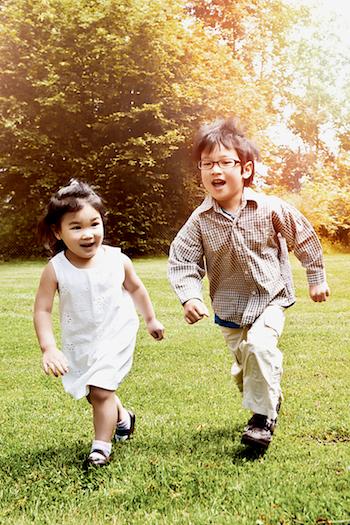On your marks, get set go
Duration/age

Get ready, get set, go!
There are lots of different ways that you can have races at home, at the park or at the beach. You can race against each other or just against the clock.
You and your child can run, jump or hop over a set distance.
How fast can you run from here to the tree? Can you get there as fast if you hop? What about if you crawl?
Reusable grocery bags make excellent sacks for a sack race. Just get your child to step inside, pull the handles up tightly and jump.
How many jumps can you do? Why don’t I count them with you?
For something different, you can have an egg and spoon race. Use a hard-boiled egg or even a plastic or wooden one. Balance it on a large spoon and see how far your child can walk with it.
Slowly, slowly - keep going. Look how far you’ve come. That’s great!
Little beanbags can be good props for races, too.
How fast can you walk with a beanbag on your head, your shoulder or your back?
Materials you will need
- Spoon
- Grocery bags
- Hard-boiled egg
- Beanbags
Alternative tools
- Wooden or plastic eggs
Why does this matter?
When children are racing they are learning about measuring. They will be gaining an understanding of time, distance and quantity. If there is more than one person racing they will also learn about positional language like first, second, third, last.
These activities also help children to strengthen their gross, or big, and fine muscles and coordination.
What does this lead to?
We use measurement in many ways every day. Having a sense of how long a minute or 100 metres is helps us to estimate, in this case, time and length. Knowing language like first, second, third helps a child to organise their thinking.
Fine and gross motor skills and coordination all support children as they write.
Language to use
- Here, there
- Fast, slow, careful
- Balance, carry
- Jump, run, crawl, skip, hop
- First, second, third, last
- Head, shoulder, back, knee
- Time, clock, watch, minute, second
Questions to use
- How far did you run this time? Can you run further this time?
- What is the fastest way that you could get to the fence?
- How far can you carry the egg on the spoon?
Useful tips
- You might also like to take a look at the Up, over, under, through activity.
- Remember to talk to you child in your home language
More ideas
- Use a stopwatch to time how long your child takes to do these activities. Show them the time and explain what the numbers mean.
- Hold races about who can pick up the toys faster or who can hop into bed first.
Variation by age
Three to five year olds
- Have a car or ball race. Prop a board or piece of thick cardboard up on a slope. Hold two or more items at the top of the board and let them go. Which one is fastest? You can try it with toy cars, balls or marbles.
- Watch raindrops sliding down a window. Chose two or three and see which one gets to the bottom first.
Questions to ask
- Does a golf ball or a tennis ball go faster?
- What else can you find that will roll down the slope?
- Why don’t some things roll?
- What happened to the drops?
Language to use
- Slope, roll, slide
- Faster, slower
- Raindrop


